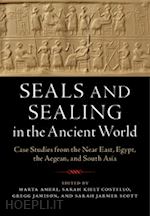Marta Ameri is an Assistant Professor of Art History at Colby College, Maine where she teaches courses focusing on Ancient, Medieval, and Islamic Art. Her research focuses of the role the seals play as markers of identity and as indicators of intercultural exchange in the Ancient Near East and South Asia. Her current research focuses on the visual analysis of seals of the Indus Valley Civilization. She is also working on a detailed study of the seals and other artifacts of administration found at the site of Shahr-i Sokhta in Iran. She has excavated in Italy, Greece, Turkey, Syria, India, and Oman.
Sarah Kielt Costello, Assistant Professor of Art History at the University of Houston, Clear Lake, is co-director of the Collections Analysis Collaborative (CAC), a research initiative with Rice University, Houston and Houston's Menil Collection, focused on the art of the ancient Mediterranean World. She has conducted field research in Cyprus, Turkey, Israel, and Greece, and in 2013 studied in Greece as a Fulbright Fellow in the Summer Session at the American School of Classical Studies, Athens. In 2012, she was awarded the Provost's Teaching Excellence Award at the University of Houston. She is a member of the Archaeological Institute of America, the American Schools for Oriental Research, and CAA.
Gregg Jamison is an Assistant Professor of Anthropology at the University of Wisconsin, Madison. His research focuses on seal production and use in the Indus Civilization, combining experimental, ethnoarchaeological, and formal stylistic approaches to link variability in carving styles and techniques with the social, economic, and political structures in which it took place. More broadly, Gregg is interested in craft production and the organizational dynamics of the world's earliest urban societies. He received his Ph.D. from the Department of Anthropology at the University of Wisconsin, Madison.
Sarah Jarmer Scott received her Ph.D. in the History of Art from the University of Pennsylvania in 2005. She has worked at the Metropolitan Museum of Art, and since 2007 been teaching at Wagner College where she is Associate Professor of Art History. Her dissertation examined Early Dynastic seal imagery from Ur, looking specifically at its relationship to early cuneiform writing. In additional to publications on Assyrian palace reliefs, she has published on curatorial projects at the Anderson Galleries in Buffalo, the pedagogy of Art History, and Community Art and Civic Engagement. She has excavated in Italy, Tunisia, and Greece.











